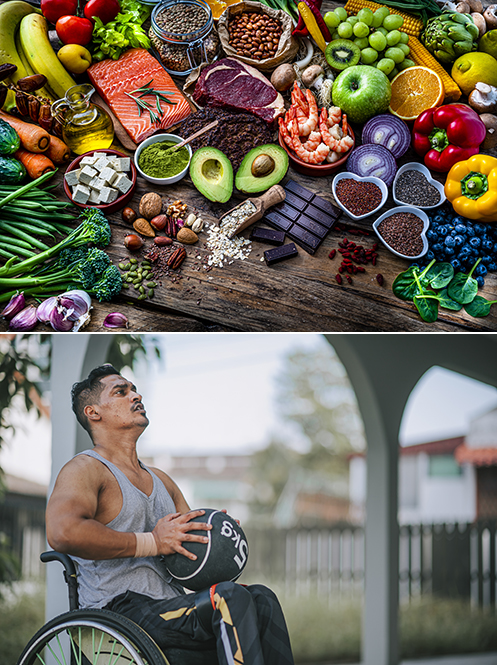Disability Health & Wellness Initiatives
The Division collaborates with policy makers, health educators, public and private agencies, and experts in the field of health and wellness on projects and initiatives.
DDS aims to promote healthy living and prevention of secondary conditions for people with disabilities and create healthier, more inclusive communities through policy, systems, and environmental changes.
Current and Upcoming Projects
Promoting Inclusive Prevention and Intervention Efforts for Sexual and Domestic Violence Assault Survivors with Disabilities (STOP Violence Against Women Act)
Research indicates that individuals with disabilities experience higher rates of interpersonal violence, including sexual abuse, domestic violence, and financial abuse (Hughes et. Al, 2011) and face additional barriers to help-seeking (Plummer & Findley, 2011).
A number of gaps exist within the delivery of services to victims of violence with disabilities. The New Jersey Division of Disability Services (DDS) is committed to addressing these gaps by working in partnership with sexual and domestic violence service providers in the state.
With generous support from the New Jersey Department of Law and Public Safety, Office of the Attorney General, DDS is leading a five-phase policy, system, and environmental change initiative to promote inclusive prevention and intervention efforts for sexual and domestic violence assault survivors with disabilities.
Improving Access to Equitable, High Quality, Evidence-based Services and Supports for New Jerseyans with TBI and Their Families
According to the NJ Commission on Brain Injury Research, approximately 12,000 - 15,000 individuals suffer brain injuries from traumatic events each year, of which 1000 are fatal. Both genders are at risk for TBI and follow similar patterns, but the incident rates for males are 2-4 times higher.
During this five-year project, funded by the Administration for Community Living, the Division of Disability Services, in partnership with the New Jersey Advisory Council on Traumatic Brain Injury and the Brain Injury Alliance of New Jersey, are building on the existing infrastructure for addressing traumatic brain injury, to expand and maintain a statewide coordinated system of services and supports that maximizes the overall health and well-being of people living with TBI.
The goals of this project are to collaborate with key stakeholders and people living with TBI (including individuals from diverse and underserved populations) to create a state plan that will drive improvement of TBI services; increase TBI surveillance and other relevant comprehensive data collection to guide TBI-related efforts; create a greater understanding of state demographics, resources, and program impact; and, coordinate public investment in effective, high-quality, equitable, evidence-based services and supports for all individuals living with TBI, with an emphasis on addressing barriers faced in Black and Hispanic communities, rural counties, and low SES populations.
Emergency Planning and Disaster Preparedness for People with Disabilities
When addressing the health and overall wellness of a person with a disability, disaster and emergency preparedness must be taken into consideration. It is important that people with disabilities and their family members make plans to protect themselves in the event of disasters.
With two sub-grants awarded by the Department of Law and Public Safety's Office of Emergency Management, the Division was able to develop materials designed to educate people with disabilities in disaster preparedness, host training sessions in locations throughout New Jersey on the topic and distribute up to 2,000 emergency supply kits or “go bags” to attendees.
A “go bag”, an important item when ensuring emergency preparedness for everyone, and especially individuals with disabilities, is a bag packed with essential items, kept ready for use in the event of an emergency evacuation of one's home.
NJ Office of Emergency Management: Your Kit/Your Plan
NJ Office of Emergency Management-For Access & Functional Needs
Service Animal Emergency Preparedness Guidance – for Handlers
Service Animal Guidance – for Emergency Shelter Managers and Workers
Key Facts About Service Animals for Disaster Shelter Workers
Hurricane Survival Guide for New Jersey
Personal Disaster Preparedness for People with Disabilities Social Media Toolkit | Ready.gov
Dietary Guidelines for Americans 2020-2025
Jointly published by the U.S. Departments of Agriculture (USDA) and Health and Human Services (HHS) every five years, the Dietary Guidelines provide science-based recommendations designed to foster healthy dietary patterns for Americans of all ages – from birth through older adults. Importantly, the latest edition expands the guidance to include recommended healthy dietary patterns for infants and toddlers.
Key recommendations include following the four overarching guidelines below:
- Following a healthy dietary pattern at every life stage;
- Customizing and enjoying nutrient-dense food and beverage choices to reflect personal preferences, cultural traditions, and budgetary considerations;
- Focusing on meeting food group needs with nutrient-dense foods and beverages from five food groups – vegetables, fruits, grains, dairy and fortified soy alternatives, and proteins – and staying within calorie limits; and
- Limiting foods and beverages higher in added sugars, saturated fat, and sodium, and limiting alcoholic beverages.
For assistance making healthy food choices, the USDA also offers the helpful Start Simple with MyPlate app and a food guidance system at myplate.gov. With these free resources, you can:
- Learn how much you need from each food group. Get a personalized MyPlate Plan that's right for you, based on your age, sex, height, weight, and physical activity level.
- Take a look at your current eating routine. Pick one or two ways that you can switch to choices today that are rich in nutrition.
- Think about how your food choices come together over the course of your day or week to help you create a healthy eating routine.
- Choose options for meals, beverages, and snacks that have limited added sugars, saturated fat, and sodium.
US Office of Disease Prevention & Health Promotion offers information on food and nutrition; physical activity; health literacy; and healthy aging.

Related Links

 Official Site of The State of New Jersey
Official Site of The State of New Jersey